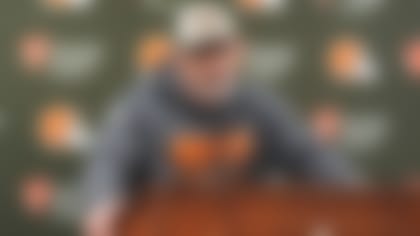After Day 1 of the 2019 NFL Draft, I used a model that predicts future player performance to identify the five best value picks of the first round. With Rounds 2 and 3 officially in the books, I've analyzed the 71 total picks from Friday night to determine the five best Day 2 values.
Note: For an explanation of how the model works, click over to the list of value picks from Day 1.
1) Jawaan Taylor, OT, Jacksonville Jaguars
Drafted No. 35 overall
When I created my analytics-based mock draft, I paired Taylor with the Jaguars ... at No. 7 overall. The fact they drafted him at No. 35 (trading up from No. 38) means that, for me, he's an excellent value. Taylor played right tackle at Florida and projects to slide into that role in Jacksonville. This means he'll line up on the opposite side of another SEC tackle for whom the Jags traded up in the second round two drafts ago -- 2017 34th overall pick Cam Robinson.
Putting Taylor's 2018 college film to the computer vision test, the first thing that jumps out is that he kept defenders at least five feet from his quarterback on passing snaps at the second-highest rate among FBS tackles. On third down and more than 6 yards to go (one way to select for more "obvious" passing downs), he ranked first in this metric. Measuring his ability to maintain leverage on rushing plays on first down (preventing a defender from stopping the gain of rushers), Taylor ranked third among FBS tackles.
Last season, Jacksonville allowed 53 sacks (tied for 29th in the NFL). Free-agent newcomer Nick Foles has to be happy about this pick.
2) J.J. Arcega-Whiteside, WR, Philadelphia Eagles
Drafted No. 57 overall
Before the draft started, Arcega-Whiteside ranked as my No. 38 overall player, so the fact that he was picked at No. 57 is one easy-to-see indicator of the value. However, his fit within the Eagles' offense makes him so much more valuable than a 19-pick differential can indicate.
One of the things that stands out most about the Stanford pass catcher is his red-zone production. Over the past two seasons, he scored a touchdown on 18 of his 34 red-zone targets (Pro Football Focus tracks this for all FBS schools), and his 52.9 percent TD rate paces all receivers over that time span. I also love two other PFF notes on him: He caught 57.1 percent of his deep targets last season, good for second in FBS, and eight of his 14 touchdowns were on deep targets. When I track his route running, it's precise for the entire route tree. This is certainly not true of all of the receivers in this draft.
In 2017, Carson Wentz had the NFL's best red-zone passer rating (116.0) and tied for the second-most touchdowns (23) without an interception. In 11 games in 2018, those results dropped to 10th in passer rating (101.7) with 18 touchdown passes and 1 interception in the red area. This might not seem huge, but consider that Wentz went 11-2 as the Eagles' starter in 2017 and 5-6 in 2018. Arcega-Whiteside adds efficiency to the Eagles' offense from Day 1.
3) Chase Winovich, Edge, New England Patriots
Drafted No. 77 overall
Let me be the first to tell you that a lot of fibs are spread around regarding how teams feel about certain prospects before they're chosen, and a lot of revisionist history is written after ... but two of my most trusted coaching contacts -- who work for teams in different conferences -- both, separately and unprovoked, told me there's a good chance Winovich finishes the 2019 season with the third-most sacks among rookies.
I love being able to add to the anonymous sourcing, but for me, there's a lot of substance to support those predictions. At pick No. 77, Winovich, who had 53 pressures at Michigan last season (per PFF, tied for third in the Big Ten) was my 31st-ranked overall player. Winovich certainly benefited from Michigan's defensive scheme and his high-caliber teammates, but his play was even better than his stats suggest. There is a silver lining to this, though, as past players with computer-vision tracking results comparable to his have had excellent production in sub-packages (and non-base fronts).
4) Justin Layne, CB, Pittsburgh Steelers
Drafted No. 83 overall
Layne addresses a big need for the Steelers' defense and is a great strategic fit with the team's first-round pick, linebacker Devin Bush.
The former Michigan State corner had the lowest yards per target allowed in coverage in FBS since 2017 (4.5 yards per target allowed) and allowed just four deep receptions on 14 deep targets over the past two seasons, per PFF.
Michigan State boasted the best run defense in college football last season (77.9 rushing yards per game), so it's possible Layne's production was actually undervalued to some degree. When I use computer vision to track him when he's targeted on first down only (to limit the number of snaps in "obvious" passing situations), he ranks among the top five in FBS in completion percentage against.
Layne is an excellent upside pick for a defense that only had eight interceptions last season (28th in the NFL).
5) David Montgomery, RB, Chicago Bears
Drafted No. 73 overall
The Bears traded up 15 spots to snag the Iowa State back -- my 54th-ranked player -- who generated the most missed tackles forced on rushes (99) and total (102) in FBS last season, according to PFF. Their math counts his missed-tackle-per-rush rate as 38.7 percent (best in FBS), which aligns really well with what I can track with computer vision. My model shows that he gained more yards using change of direction than any back in FBS over the past two seasons.
His 58 receptions over the past two seasons show versatility, and his pass-catching prowess significantly increases the Bears' running back efficiency position rating (which includes passes to RBs). Last season, the Bears averaged 4.14 yards per rush (27th best in the NFL) and 5.27 yards per play on first down (25th). Montgomery projects to help increase Chicago's production in these two areas, especially.
Follow Cynthia Frelund on Twitter @cynthiafrelund.












